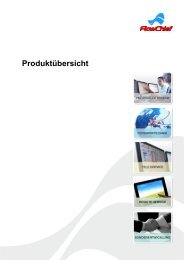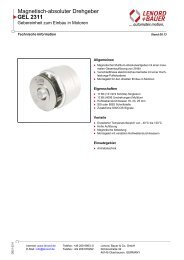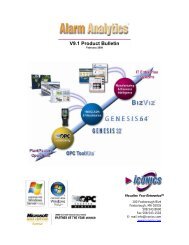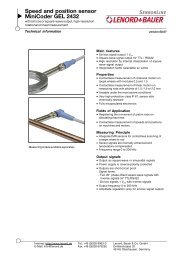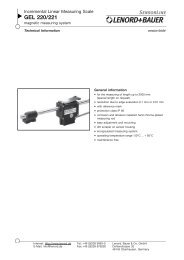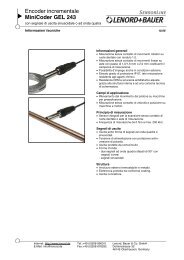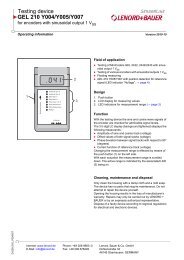x - Lenord+Bauer
x - Lenord+Bauer
x - Lenord+Bauer
You also want an ePaper? Increase the reach of your titles
YUMPU automatically turns print PDFs into web optimized ePapers that Google loves.
Copyright AREVA Wind/Jan Oelker<br />
SenSorS and control SyStemS<br />
in wind turbineS
2<br />
1<br />
2<br />
Sensors and control systems from lenord + bauer<br />
15 years of experience and more than 30,000 installations<br />
worldwide<br />
Modern wind turbines are masterpieces of the art of engineering. They defy<br />
sub-tropical heat, arctic cold, dirt, humidity and salt mist, as well as the<br />
continuous vibration in the nacelle. At the same time they operate around the<br />
clock, 365 days a year. For this reason wind turbine manufacturers – just like the<br />
manufacturers of rail vehicles – are among the most demanding customers in<br />
the area of automation technology.<br />
Lenord + Bauer has been tackling this challenge for decades! Irrespective of<br />
whether measurement, control or regulation: our robust automation products<br />
and magnetic sensors provide optimal prerequisites for the complete<br />
monitoring and the safe operation of all rotating components in a wind turbine.<br />
With this brochure we would like to give you an overview of the products<br />
from our overall portfolio that are proven in wind turbines. In principle, all<br />
products can be adapted to the specifications for your individual installation.<br />
We would be pleased to advise you in a personal meeting.<br />
3<br />
7<br />
9<br />
5
6 8<br />
4<br />
diverse applications – one system supplier<br />
lenord + bauer<br />
1 Pitch motor: position detection and speed measurement<br />
2 Blade bearing: position detection<br />
3 Pitch system: control of rotor blade position<br />
4 Sub-system: control of the temperature management<br />
5 Tower: measurement of the tower oscillation<br />
6 Slip ring: position detection and speed measurement<br />
7 Powertrain: position and speed measurement on the main shaft<br />
8 Generator: speed measurement<br />
9 Azimuth: position detection of the nacelle<br />
Source: Wind-to-Energy GmbH, Rostock<br />
3
4<br />
Pitch motor<br />
Pitch motor<br />
Position detection and speed measurement<br />
For optimal energy yield, pitch-controlled wind turbines<br />
do not just align their hub to suit the wind speed and<br />
direction, but also their blades.<br />
Lenord + Bauer absolute rotary encoders with integrated<br />
bearings are proven in the exact adjustment of the blade<br />
position, as they can be used straightforwardly even in<br />
case of extreme ambient temperatures, humidity, dirt,<br />
condensation or heavy vibration. The exact position of the<br />
rotor blade is acquired on the B-side of the rotor blade<br />
adjustment motor.<br />
advantages of the absolute rotary encoders<br />
from lenord + bauer<br />
:: Robust, magnetic sensors<br />
:: High resolution (max. 16 bits single turn, 28 bits<br />
multiturn)<br />
:: Suitable for offshore operation as well as applications<br />
in cold and hot climates<br />
:: Optionally available with digital SSI, CANopen or<br />
PROFIBUS-DP and analogue 0 to 10 V or 4 to 20 mA<br />
interfaces<br />
:: Durable, reliable technology<br />
:: Maintenance-free over the long-term<br />
:: IP 67 variants available<br />
our recommendation:<br />
absolute rotary encoder Gel 2037<br />
:: 25-bit resolution (13 bits single turn, 12 bits multiturn)<br />
:: SSI<br />
:: Redundant measuring system with integrated, separate<br />
resolver<br />
:: Robust design compliant with IP 67<br />
:: Heavy-duty flange for high bearing loads<br />
:: Maintenance-free thanks to mechanical gear<br />
:: Extended temperature range -40 °C to + 85 °C<br />
alternative products for this application:<br />
Gel 2035 and Gel 235 series<br />
Source: Wind-to-Energy GmbH, Rostock
Pitch motor<br />
incremental<br />
position detection and speed measurement<br />
The incremental rotational speed sensors from<br />
Lenord + Bauer are proven in the acquisition of the<br />
rotational speed of the rotor blade adjustment motor;<br />
these sensors scan a target wheel connected to the motor<br />
shaft. The sensors are significantly smaller than absolute<br />
rotary encoders with integrated bearings, but just as<br />
robust in relation to ambient effects. As they scan the<br />
toothed wheel contactlessly, they operate completely<br />
maintenance-free and wear-free.<br />
Redundant feedback systems can be realised easily by<br />
scanning a target wheel using two or more sensors.<br />
advantages of the speed sensors<br />
from lenord + bauer<br />
:: Robust, magnetic sensors<br />
:: High accuracy in a speed range of 0 to 25 kHz<br />
:: Suitable for offshore operation as well as applications<br />
in cold and hot climates<br />
:: Optionally available with either HTL or TTL signal output<br />
:: Completely wear-free and maintenance-free<br />
:: Robust design compliant with IP 68<br />
our recommendation:<br />
encoder kit Gel 248<br />
:: Magnetic scanning of toothed wheels, racks or slotted<br />
discs<br />
:: Target wheels: modules 0.7 to 4.0 can be scanned<br />
:: Extended temperature range -40 °C to +120 °C<br />
:: Data acquisition at standstill<br />
:: Acquisition of slow movements without loss of pulses<br />
:: Particularly compact design ideally suited to use in<br />
limited space envelopes<br />
alternative products for this application:<br />
Gel 247 series<br />
Pitch motor<br />
Source: Wind-to-Energy GmbH, Rostock<br />
5
6<br />
Blade bearing<br />
blade bearing:<br />
Position detection<br />
In addition to rotational speed and position acquisition on<br />
the pitch motor, it is possible to determine the rotor blade<br />
position almost free of play using a rotational speed<br />
acquisition at the root of the blade. For this purpose an<br />
absolute rotary encoder with integrated bearings is fitted<br />
with a flexible flange; this encoder engages directly with<br />
the teeth on the blade bearing.<br />
The advantage of this variant is that direct acquisition at<br />
the root of the blade prevents errors in the measured<br />
values due to an intermediate gearbox.<br />
advantages of the absolute rotary encoders<br />
from lenord + bauer<br />
:: Robust, magnetic sensors<br />
:: Complete system available comprising bracket, flexible<br />
flange, rotary encoder, target wheel and cable set<br />
:: High resolution (max. 16 bits single turn, 28 bits<br />
multiturn)<br />
:: Suitable for offshore operation as well as applications<br />
in cold and hot climates<br />
:: Optionally available with digital interface SSI, CANopen<br />
or PROFIBUS-DP and analogue interface 0 to 10 V or<br />
4 to 20 mA<br />
:: Optionally available as IP 67 or IP 69 K variant<br />
our recommendation:<br />
absolute rotary encoder Gel 235<br />
:: 28-bit resolution (16 bits single turn, 12 bits multiturn)<br />
:: Accuracy better than 0.09 °, high linearity<br />
:: Dew-point resistant<br />
:: Shock and vibration-resistant<br />
:: Extended temperature range -40 °C to +105 °C<br />
:: Heavy-duty flange for high bearing loads<br />
:: Maintenance-free over the long-term thanks to mechanical<br />
gear<br />
:: Optionally available with digital interface SSI, EtherCAT,<br />
CANopen or PROFIBUS-DP and analogue interface<br />
0 to 10 V or 4 to 20 mA<br />
alternative products for this application:<br />
Gel 2035; Gel 2037<br />
Source: Wind-to-Energy GmbH, Rostock
Pitch system:<br />
control of rotor blade position<br />
Modern wind turbines use complex, cascaded control loops<br />
to efficiently control the installation. An important<br />
sub-system here is the control system for the rotor blade<br />
position.<br />
The compact control systems from Lenord + Bauer have<br />
been proven in this demanding application over the last<br />
15 years. They have a compact design, a wide range of<br />
interfaces and are suitable in particular for the adverse<br />
temperature and environmental conditions in the<br />
nacelles. They are used both for condition monitoring and<br />
for the control of the blade angle.<br />
advantages of the compact control systems<br />
from lenord + bauer<br />
:: Compact construction without fan<br />
:: Due to the use of lacquered printed circuit boards,<br />
suitable for offshore operation as well as applications in<br />
cold and hot climates<br />
:: Shock and vibration-resistant<br />
:: Weather-resistant, integrated display with membrane<br />
keyboard<br />
:: Comprehensive fieldbus interfaces<br />
:: Remote service web function<br />
:: More than 20,000 installations worldwide<br />
our recommendation:<br />
control system Gel 8251<br />
:: Integrated, freely programmable PLC<br />
:: Extended temperature range from -20 °C to +70 °C with<br />
maximum atmospheric humidity of up to 95 %<br />
:: 30/15 digital IN/OUT, 3/3 analogue IN/OUT, 4 x PT100<br />
:: 6 absolute encoder inputs (SSI) for the connection of<br />
rotor blade and/or pitch motor rotary encoders<br />
:: 2 CANopen interfaces on board<br />
alternative products for this application:<br />
Gel 8230 and Gel 8232 series<br />
Pitch system<br />
Source: Wind-to-Energy GmbH, Rostock<br />
7
8<br />
Sub-system<br />
Sub-system<br />
control of the temperature management<br />
Modern wind turbines for generating energy are proven not<br />
only in moderate climatic zones, but in the meantime also<br />
in sub-polar and sub-tropical regions. However, these<br />
so-called hot or cold climate locations require active<br />
temperature management that protects the power<br />
electronics and also gears or energy stores against<br />
failures and damage.<br />
The fieldbus controller series from Lenord + Bauer was<br />
specially designed for this application and is available with<br />
customised software for decentral temperature management<br />
in wind turbines.<br />
advantages of the control system<br />
from lenord + bauer<br />
:: Can be used decentrally<br />
:: Extended temperature range -50 °C to +85 °C<br />
:: Dew-point resistant<br />
:: Suitable for hot climate and cold climate<br />
:: High shock and vibration resistance<br />
:: Compact, slender design for mounting on top hat rails<br />
:: Installation-specific software variants<br />
:: Software parameters can be set using Windows service<br />
tool<br />
our recommendation:<br />
Fieldbus terminal controller Gel 8500<br />
:: CANopen (CiA 301 + CiA 401)<br />
:: 6/6 digital IN/OUT, 2 x 230 V AC OUT, 4 x PT100<br />
:: Operating temperature of -40 °C to +85 °C<br />
:: Maximum installation altitude 3,000 m<br />
:: USB service port<br />
:: Integrated high-power MosFETs for the direct operation<br />
of loads or contactors<br />
alternative products for this application:<br />
Gel 8230b202; Gel 8232b202<br />
Source: Wind-to-Energy GmbH, Rostock
tower<br />
measurement of the tower oscillation<br />
Despite careful design and workmanship, oscillations<br />
occur during the operation of wind turbines; these<br />
oscillations continuously subject the structure and materials<br />
to mechanical stress.<br />
Lenord + Bauer has developed a special sensor that<br />
measures the tower oscillations in real time and transmits<br />
the measurements via either a CANopen or EtherCAT<br />
interface to the control system for the installation. If the<br />
stipulated limits are exceeded, the installation can be<br />
shut down via a safety relay integrated into the measuring<br />
device.<br />
advantages of the tower oscillation monitor<br />
from lenord + bauer<br />
:: Can be integrated into existing safety systems<br />
:: Mature, micro-electro-mechanical system (MEMS<br />
acceleration sensors)<br />
:: Robust sensors that are not subject to any ageing<br />
whatsoever and that operate completely maintenancefree<br />
and wear-free<br />
:: Straightforward integration in EtherCAT or CANopen<br />
networks<br />
:: Dew-point resistant, compact design<br />
:: Redundant measuring system due to comparison of two<br />
acceleration sensors integrated into the measuring<br />
device.<br />
our recommendation:<br />
tower oscillation monitor Gel 3010<br />
Tower<br />
:: Optionally available with EtherCAT or CANopen interface<br />
:: Mechanically interlocked safety relay output<br />
:: Measuring range ± 20 m/s 2 (2g) with a resolution of<br />
± 0.01 m/s 2<br />
:: Frequency range 0 to 10 Hz<br />
:: Two measuring directions aligned at an angle of 90° to<br />
each other<br />
:: Protection class IP 67<br />
:: Operating temperature range -40 °C to +85 °C<br />
:: Installation altitude up to 4,000 m<br />
Source: Wind-to-Energy GmbH, Rostock<br />
9
10<br />
Slip ring<br />
Slip ring<br />
Position detection and speed measurement<br />
Modern wind turbines use slip rings to transmit data and<br />
energy between the hub and nacelle. As the slip ring rotates<br />
in synchronism with the rotor shaft, the rotor hub position<br />
and rotational speed can be acquired directly on the slip<br />
ring using a rotary encoder.<br />
The series GEL 290 incremental rotary encoders are proven<br />
in this application. Due to the flexible configuration<br />
options for incremental and absolute rotary encoders,<br />
along with the various bus covers, it is possible to realise<br />
with little effort multiply redundant tandem encoders for<br />
monitoring the rotational speed of the drive train.<br />
advantages of the tandem encoders<br />
from lenord + bauer<br />
:: Modular design makes possible real redundancy as well<br />
as the acquisition of different measured parameters<br />
:: Acceleration, rotational speed and position acquisition<br />
directly at the slow rotor shaft<br />
:: Various fieldbus interfaces available<br />
:: High-resolution, incremental output for evaluation in the<br />
wind turbine's safety system<br />
:: Overspeed detection<br />
:: Maintenance-free, durable operation in harshest<br />
conditions due to robust, magnetic sensors<br />
our recommendation:<br />
tandem encoder Gel 290<br />
:: Combination of incremental encoder with integrated<br />
bearings from the GEL 292 series with a GEL 235<br />
absolute encoder or, alternatively, a GEL 293 incremental<br />
encoder<br />
:: Optimised installation length due to modular design<br />
:: High-resolution with up to 266,240 pulses per revolution<br />
:: Integrated, highly elastic, torsionally stiff coupling<br />
:: Extremely high angular acceleration<br />
:: Robust design compliant with IP 66<br />
alternative products in this application:<br />
Gel 293, Gel 235, Gel 208<br />
Source: Wind-to-Energy GmbH, Rostock
Powertrain<br />
Position and speed measurement<br />
on the main shaft<br />
As an alternative to drive train monitoring on the slip ring,<br />
the rotor hub position, the rotor pin locking position and<br />
the rotor rotational speed can be acquired by scanning a<br />
ferro-magnetic slotted disc permanently connected to the<br />
rotor shaft.<br />
The advantage of this mounting position directly on the<br />
drive train is that acquisition errors cannot be caused by an<br />
intermediate coupling. The incremental speed sensor<br />
GEL 2495 is proven for the measurement; this sensor<br />
generates two completely separate, redundant rotational<br />
speed signals with a high number of pulses or high<br />
resolution.<br />
advantages of redundant speed sensors<br />
from lenord + bauer<br />
:: The magnetic sensors do not age<br />
:: Redundant, incremental measuring system<br />
:: High-resolution measurement of 4096 or 8192 pulses<br />
per 360°<br />
:: The contour disk used as the measuring scale is bolted<br />
directly to the wind turbine's rotor shaft free of play<br />
:: Thanks to redundant installation monitoring it is<br />
possible to shut down the wind turbine at any time in<br />
case of overspeed<br />
:: A reference signal makes it possible to move to the rotor<br />
pin locking position<br />
our recommendation:<br />
Speed sensor Gel 2495<br />
:: Up to 8,192 pulses per turn<br />
:: Accuracy ± 0.05 °<br />
:: High shock and vibration resistance<br />
:: Dew-point resistant<br />
:: Extended temperature range -40 °C to +85 °C<br />
:: Robust design compliant with IP 67<br />
alternative products for this application:<br />
Gel 247, Gel 248<br />
Powertrain<br />
Source: Wind-to-Energy GmbH, Rostock<br />
11
12<br />
Azimuth<br />
azimuth<br />
Position and speed measurement on the main shaft<br />
The exact tracking by the nacelle of changing wind directions<br />
is a crucial factor for optimal energy yield. The<br />
central element here is the toothed azimuth bearing that<br />
connects the nacelle to the tower. It is therefore ideally<br />
suited to the precise acquisition of the rotational speed<br />
and position of the nacelle.<br />
Lenord + Bauer has developed a measuring system<br />
especially for this application; in addition to an absolute<br />
rotary encoder, this system comprises a bracket, flexible<br />
flange, target wheel and cable set.<br />
advantages of the absolute rotary encoders<br />
from lenord + bauer<br />
:: High external shaft loads are possible due to optimised<br />
bearings<br />
:: Robust, magnetic sensors<br />
:: High resolution (16 bits single turn, 28 bits multiturn)<br />
:: Suitable for offshore operation as well as applications in<br />
cold and hot climates<br />
:: Optionally available with digital interface SSI, CANopen or<br />
PROFIBUS-DP and analogue interface 0 to 10 V or<br />
4 to 20 mA<br />
:: Maintenance-free over the long-term in single turn and<br />
geared multiturn operation<br />
:: Optionally available as IP 67 or IP 69 K variant<br />
our recommendation:<br />
absolute rotary encoder Gel 235<br />
:: 16-bit single turn, 12-bit multiturn<br />
:: Accuracy better than 0.09 °, high linearity<br />
:: Temperature range -40 °C to +105 °C<br />
:: Complete system available comprising bracket, flexible<br />
flange, rotary encoder, target wheel and cable set<br />
alternative products for this application:<br />
Gel 2035, Gel 2037<br />
Source: Wind-to-Energy GmbH, Rostock
Generator<br />
Speed measurement<br />
To convert mechanical power into electrical power, wind<br />
turbines use three-phase generators with mains converters.<br />
To ensure high mains quality with variable rotational speed<br />
operation, the rotor speed is acquired continuously and<br />
processed in a feedback system.<br />
The incremental rotary encoders from Lenord + Bauer are<br />
particularly suitable for the reliable acquisition of the<br />
generator speed.<br />
advantages of incremental rotary encoders<br />
from lenord + bauer<br />
:: Integrated, highly elastic, torsionally stiff coupling<br />
:: The magnetic sensors do not age<br />
:: Extremely shock and vibration-resistant<br />
:: Dew-point resistant<br />
:: High number of pulses of up to 266,240 increments per<br />
turn<br />
:: Insulated construction<br />
our recommendation:<br />
rotary encoder Gel 293<br />
:: Operating temperature range -20 °C to +85 °C<br />
:: Storage temperature range -40 °C to +105 °C<br />
:: Various output signal patterns possible<br />
:: Maintenance-free over the long-term<br />
:: Suitable for offshore, cold climates and hot climates<br />
alternative products for this application:<br />
Gel 247, Gel 248<br />
Generator<br />
Source: Wind-to-Energy GmbH, Rostock<br />
13
14<br />
Products and solutions<br />
customer-specific products and solutions<br />
For more than 15 years Lenord + Bauer has been supplying<br />
the manufacturers of wind turbines. More than 20,000<br />
control systems and countless sensors are in continuous<br />
use in a very wide range of climate zones worldwide.<br />
Many of these products are customer-specific solutions<br />
we have adapted to the individual requirements of<br />
different wind turbine manufacturers. Along with software<br />
Hardware<br />
:: Basic development<br />
:: 16/32 bit micro controller, power PC<br />
:: Analogue and digital technology<br />
:: Fieldbus interfaces<br />
:: Housing technology<br />
2 Blade bearing: position acquisition<br />
5 Tower: measurement of the tower oscillation<br />
modifications, different interfaces or cable outlets, these<br />
sensors and control systems differ from our standard<br />
range to some extent even in their electronic components.<br />
Due to our high level of vertical integration, we are able to<br />
quickly develop customer-specific products and solutions.<br />
Call us. We would be pleased to talk to you about custom<br />
solutions for your application.<br />
application<br />
:: Creation of control concept<br />
:: Fieldbus concept<br />
:: Environmental conditions<br />
:: Interface definition<br />
2<br />
5<br />
design<br />
:: Circuit diagram layout<br />
:: Printed circuit board<br />
layout<br />
:: EMC design<br />
:: Housing technology<br />
:: Component type test<br />
Software<br />
:: Operating system<br />
:: Runtime system (e.g.<br />
CoDeSys)<br />
:: Application software<br />
:: Operating software<br />
:: Web technology<br />
communication<br />
:: Modbus TCP
your contact at lenord + bauer<br />
For new developments and/or further developments<br />
you will find the right contact for your projects in<br />
Lenord + Bauer. We offer you our know-how and our<br />
support.<br />
Technical support<br />
Software applications<br />
Renewable energies / wind<br />
support-windpower-application@lenord.de<br />
Technical Support<br />
+49 208 9963 - 215<br />
You have technical questions concerning our products?<br />
Do you need help with commissioning? Our competent<br />
support staff in the office will be happy to offer you advice<br />
and practical help.<br />
support@lenord.de<br />
Customer Service Center<br />
+49 208 9963 - 216<br />
You urgently need the products, or have questions on<br />
delivery conditions, repairs or status of a current order?<br />
Our Customer Service Center will assist you with commercial<br />
queries!<br />
costumer-service-center@lenord.de<br />
call center<br />
+49 208 9963 - 0<br />
Are you looking for a competent contact person or the<br />
relevant employee for your topic in our company? Our<br />
call center will be happy to assist you!<br />
info@lenord.de<br />
Technical support<br />
Renewable energies / wind<br />
support-windpower@lenord.de<br />
Contact<br />
15
lenord, bauer & co. GmbH<br />
Dohlenstraße 32, 46145 Oberhausen, Germany<br />
Phone +49 (0)208 9963-0 Fax +49 (0)208 676292<br />
info@lenord.de www.lenord.de<br />
D0051-Broschüre Wind (08.12)



